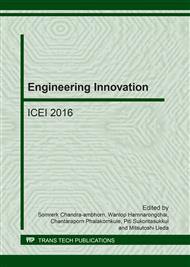p.209
p.215
p.223
p.229
p.235
p.240
p.246
p.252
p.258
Investigation on Fracture Behavior of Glass Fiber Reinforced Thermoplstic and Thermosetting Composites
Abstract:
Glass fiber reinforced thermoplastics and thermosetting composites were prepared in this study. Commercial grades of 20% glass fiber filled polypropylene, polyoxymethylene, polyamide 6 and polycarbonate were injection molded to dumbbell specimens. The specimens are referred as GF/PP, GF/POM, GF/PA and GF/PC, respectively. 55% GF reinforced novolak composites were fabricated by hand lay-up, which different curing times of 20 s, 35 s and 50 s. Mechanical properties, fracture behavior and morpgology of GF composites with and without notched were investigated. GF/PA showed the highest properties of tensile properties, notched strength and fracture toughness as compared to all of GF reinforced thermoplastics in this research. On the other hand, tensile properties and fracture toughness of GF reinforced novolak increased with increasing curing times. SEM photographs indicated ductile fractured surface near the crack edge while their brittle appeared at far of the crack in GF reinforced thermoplastics. It can be noted that notched sensitivity of GF reinforced thermoplastics was lower than GF reinforced thermosetting composites.
Info:
Periodical:
Pages:
235-239
Citation:
Online since:
January 2017
Keywords:
Price:
Сopyright:
© 2017 Trans Tech Publications Ltd. All Rights Reserved
Share:
Citation:


